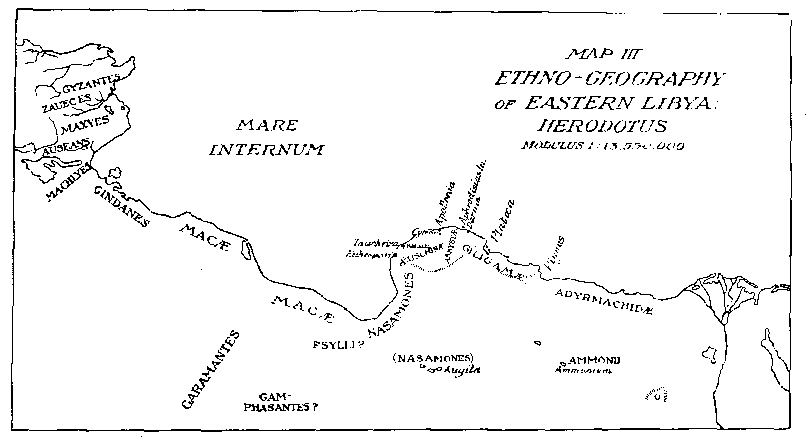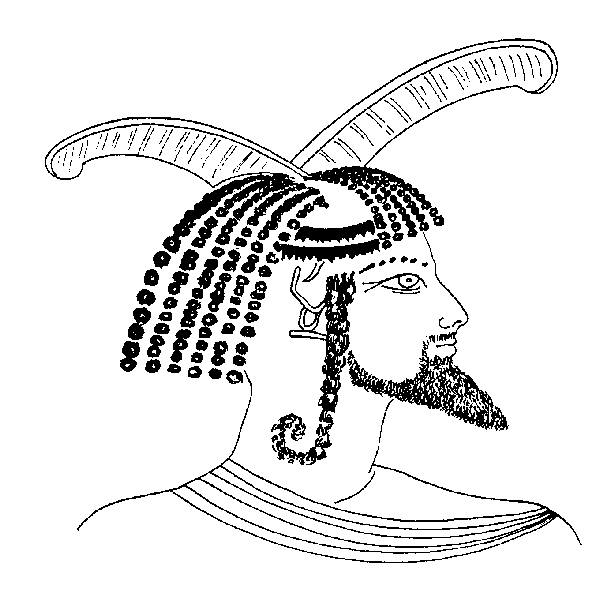|
On the Course of the Nile (Herodotus)
I did however, hear a story from some people
of Cyrene, who told me that during a visit to the oracle of Ammon
they happened , in the course of conversation with Etearchus the
Ammonian king, to get on to the subject of the Nile and the riddle
of its source. Etearchus told them that he had once had a visit
from certain Nasamonians, a people who live in Syrtis and the
country a little to the eastward. Being asked if there was anything
more they could tell him about uninhabited parts of Libya, these
men declared that a group of young fellows, sons of chieftains
in their country, had on coming -to manhood planned amongst themselves
all sorts of extravagant adventures, one of which was to draw
lots for five of their number to explore the Libyan desert and
try to penetrate further than had ever been done before. The whole
Mediterranean coast of Libya from Egypt to Cape Soloïs, where
it ends, is inhabited by many different tribes of Libyans, except
the portion which is possessed by Greeks and Phoenicians; but
in the inland parts lying to the southward of the inhabited coastal
district only wild beasts are to be found, and further still to
the southward there is a waterless and sandy desert lout life
of any kind. The story then was that the young men, sent off by
their companions on their travels with a good supply of food and
water, passed through tile inhabited parts of the country to the
region of wild beasts and then came to the desert, which they
proceeded to cross in a westerly direction. After travelling for
many days over the sand they saw some trees growing on a level
spot; they approached and began to pick the fruit which the trees
bore, and while they were doing so were attacked by some little
men - of less than middle height - who seized them and carried
them off. The speech of these dwarfs was unintelligible, nor could
they understand the Nasamonians. They took their captives through
a vast tract of marshy country, and beyond it came to a town,
all the inhabitants of which were of the same small stature, and
all black. A great river with crocodiles in it flowed past the
town from west to east.
On the Garamantes (Herodotus)
Further inland to the southward, in the part
of Libya where wild beasts are found, live the Garamantes, who
avoid all intercourse with men, possess no weapons of war, and
do not know how to defend themselves. Along the coast to the westward
the neighbours of the Nasamones are the Macae. These people wear
their hair in the form of a crest, shaving it close on either
side of the head and letting it grow long in the middle; in war
they carry ostrich skins for shields. The river Cinyps, which
rises on a hill called the Hill of the Graces, runs through their
territory to the sea. The Hill of the Graces is about twenty-five
miles inland, and is densely wooded, unlike the rest of Libya
so far described, which is bare of trees.
…Ten days' journey west of the Ammonians, along the belt
of sand, there is another similar salt-hill and spring. This place,
called Augila, is also inhabited and it is here that the Nasamonians
come for their date harvest. Again at the same distance to the
west is a salt-hill and spring, just as before, with date palms
of the fruit-bearing kind, as in the other oases; and here live
the Garamantes, a very numerous tribe of people, who spread soil
over the salt to sow their seed in. From these people is the shortest
route—thirty days' journey—to the Lotophagi; and it
is amongst them that the cattle are found which walk backwards
as they graze. The reason for this curious habit is provided by
the formation of their horns, which bend forwards and downwards;
this prevents them from moving forwards in the ordinary way, for,
if they tried to do so, their horns would stick in the ground.
In other respects they are just like ordinary cattle—except
for the thickness and toughness of their hide. The Garamantes
hunt the Ethiopian hole-men, or troglodytes, in four-horse chariots,
for these troglodytes are exceedingly swift of foot—more
so than any people of whom we have any information. They eat snakes
and lizards and other reptiles and speak a language like no other,
but squeak like bats.
Pliny's account
of the army led by Balbus in the Fezzan against the Garamantes
…Beyond the Lesser Syrtis is the region of Phazania; the
nation of Phazanii belonging to which, as well as the cities of
Alele and Cilliba, we have subdued by force of arms, as also Cydamus,
which lies over against Sabrata. After passing these places a
range of mountains extends in a prolonged chain from east to west;
these have received from our people the name of Black Mountains,
either from the appearance which they naturally bear of having
been exposed to the action of fire, or else because they have
been scorched by the sun's rays. Beyond it lies the desert, and
then Talgae, a city of the Garamantes, and Debris, … Garama,
too, that most famous capital of the Garamantes, all of which
places have been subdued by the Roman arms. It was on this occasion
that Cornelius Balbus was honoured with a triumph. … Besides
Cydamus and Garama, there were carried in procession the names
and models of all the other nations and cities in the following
order; Tabudium, a town ; Niteris, a tribe ; the town of Nigligemela,
the tribe or town of Bubeium, the tribe Enipi, the town Thuben,
the mountain known as the Black Mountain, Nitibrum, the towns
called Rapsa, the tribe Discera, the town Debris, the river Nathabur,
the town Thapsagum, the tribe Nannagi, the town Boin, the town
Pege, the river Dasibari; and then the towns in the following
order, of Baracum, Buluba, Alasit, Galia, Balla, Maxalla, Zigama,
and Mount Gyri, which was preceded by an inscription stating that
this was the place where precious stones were produced.
…Up to the present, it has been
found impracticable to keep open the road that leads to the country
of the Garamantes, as the robber bands of that people have filled
up the wells with sand, which wells do not require to be digged
to any great depth, if you but have knowledge of the locality.
|


